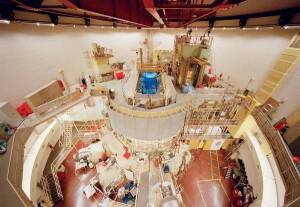High Flux Reactor Shutdown Begins
by
Brendon Nafziger, DOTmed News Associate Editor | February 22, 2010

The Petten reactor goes
out for almost six months
as repair teams try to mend
leaky pipes
The long-planned shutdown of the High Flux Reactor has begun.
On Friday morning around 8:00 am CET, the nearly 50-year-old reactor went down for almost 25 weeks of inspection and repairs, according to the Nuclear Research and Consultancy Group, which runs the site.
"We estimate that we will return to operation in the second half of August this year," Juliette van der Laan, a spokeswoman for NRG, tells DOTmed News.
The nuclear medicine community has long dreaded the shutdown of the Petten, Netherlands-based reactor. The reactor produces a significant amount of the world's supply of molybdenum-99, a precursor of technetium-99, a radioisotope critical for some nuclear medicine procedures.
While unwelcome at the best of times, the deactivation comes at an especially bad moment, as it means the world's two major isotope-producing reactors will be down simultaneously. The National Research Universal Reactor, based in Chalk River, Ontario, is offline undergoing repairs until at least April.
But the Petten reactor's shutdown is not a surprise. In 2008, workers doing routine inspections of the plant discovered bubbles, a sign of corrosion, seeping up through the cooling water pipework.
To repair it, teams have been busily training on mock drills to break up the concrete shielding the coils of pipework, and then pulling out the defective pipes and welding in new ones.
Because of the radiation risks, the process is not quite as simple as normal welding, says van der Laan.
"On the one hand, yes, removing concrete and making a weld is not the most complex procedure, but of course it is in a research reactor, and what is making it complex is that it requires a lot of time because of the radiation protection," she says.
As van der Laan explains, before the repair crews can get down to welding, they have to first lay a thick coat of a metallic substance called densimet. This tungsten alloy acts like lead, absorbing radiation to protect the workers.
Next, the team will drain the water in the reactor pool, which also acts as a protective material. Once that's emptied, they will fit in the new pipes. After the whole system is inspected by regulatory and safety authorities, they will then re-encase the fixed pipes with a fresh shield of concrete.
For those interested in following the status of Petten reactor's repairs, NRG will publish a monthly newsletter in both Dutch and English that can be found here: www.nrg.eu/hfr-reparatie.
